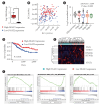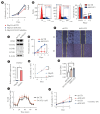DGAT2 Plays a Crucial Role to Control ESRRA-PROX1 Transcriptional Network to Maintain Hepatic Mitochondrial Sustainability
- PMID: 38644620
- PMCID: PMC11449812
- DOI: 10.4093/dmj.2023.0368
DGAT2 Plays a Crucial Role to Control ESRRA-PROX1 Transcriptional Network to Maintain Hepatic Mitochondrial Sustainability
Abstract
Backgruound: Diacylglycerol O-acyltransferase 2 (DGAT2) synthesizes triacylglycerol (TG) from diacylglycerol; therefore, DGAT2 is considered as a therapeutic target for steatosis. However, the consequence of inhibiting DGAT2 is not fully investigated due to side effects including lethality and lipotoxicity. In this article, we observed the role of DGAT2 in hepatocarcinoma.
Methods: The role of DGAT2 is analyzed via loss-of-function assay. DGAT2 knockdown (KD) and inhibitor treatment on HepG2 cell line was analyzed. Cumulative analysis of cell metabolism with bioinformatic data were assessed, and further compared with different cohorts of liver cancer patients and non-alcoholic fatty liver disease (NAFLD) patients to elucidate how DGAT2 is regulating cancer metabolism.
Results: Mitochondrial function is suppressed in DGAT2 KD HepG2 cell along with the decreased lipid droplets. In the aspect of the cancer, DGAT2 KD upregulates cell proliferation. Analyzing transcriptome of NAFLD and hepatocellular carcinoma (HCC) patients highlights negatively correlating expression patterns of 73 lipid-associated genes including DGAT2. Cancer patients with the lower DGAT2 expression face lower survival rate. DGAT2 KD cell and patients' transcriptome show downregulation in estrogen- related receptor alpha (ESRRA) via integrated system for motif activity response analysis (ISMARA), with increased dimerization with corepressor prospero homeobox 1 (PROX1).
Conclusion: DGAT2 sustains the stability of mitochondria in hepatoma via suppressing ESRRA-PROX1 transcriptional network and hinders HCC from shifting towards glycolytic metabolism, which lowers cell proliferation.
Keywords: Carcinoma, hepatocellular; Diacylglycerol O-acyltransferase; Mitochondria; Non-alcoholic fatty liver disease.
Conflict of interest statement
No potential conflict of interest relevant to this article was reported.
Figures







Similar articles
-
Histone Demethylase KDM7A Contributes to the Development of Hepatic Steatosis by Targeting Diacylglycerol Acyltransferase 2.Int J Mol Sci. 2021 Oct 14;22(20):11085. doi: 10.3390/ijms222011085. Int J Mol Sci. 2021. PMID: 34681759 Free PMC article.
-
Urokinase-type plasminogen activator (uPA) stimulates triglyceride synthesis in Huh7 hepatoma cells via p38-dependent upregulation of DGAT2.Atherosclerosis. 2014 Nov;237(1):200-7. doi: 10.1016/j.atherosclerosis.2014.09.003. Epub 2014 Sep 9. Atherosclerosis. 2014. PMID: 25244504
-
Diacylglycerol acyltransferase-2 (DGAT2) and monoacylglycerol acyltransferase-2 (MGAT2) interact to promote triacylglycerol synthesis.J Biol Chem. 2014 Oct 10;289(41):28237-48. doi: 10.1074/jbc.M114.571190. Epub 2014 Aug 27. J Biol Chem. 2014. PMID: 25164810 Free PMC article.
-
Inhibition of Diacylglycerol Acyltransferase 2 Versus Diacylglycerol Acyltransferase 1: Potential Therapeutic Implications of Pharmacology.Clin Ther. 2023 Jan;45(1):55-70. doi: 10.1016/j.clinthera.2022.12.008. Epub 2023 Jan 21. Clin Ther. 2023. PMID: 36690550 Review.
-
The role of DGAT1 and DGAT2 in tumor progression via fatty acid metabolism: A comprehensive review.Int J Biol Macromol. 2024 Oct;278(Pt 3):134835. doi: 10.1016/j.ijbiomac.2024.134835. Epub 2024 Aug 21. Int J Biol Macromol. 2024. PMID: 39154689 Review.
References
-
- Calle RA, Amin NB, Carvajal-Gonzalez S, Ross TT, Bergman A, Aggarwal S, et al. ACC inhibitor alone or co-administered with a DGAT2 inhibitor in patients with non-alcoholic fatty liver disease: two parallel, placebo-controlled, randomized phase 2a trials. Nat Med. 2021;27:1836–48. - PubMed
MeSH terms
Substances
Grants and funding
LinkOut - more resources
Full Text Sources
Medical
Research Materials
Miscellaneous

